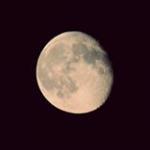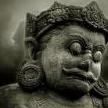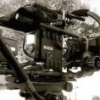Leaderboard
Popular Content
Showing content with the highest reputation on 10/24/2015 in all areas
-
for me this is one of the most useful color grading videos I have seen - the amount of work he does in each scene is remarkable. Basically he throws a lut on the end - even though it feels like it throws it on first - it's an output lut. then he makes the shot overall color, then tweaks the low, mids, and highs. he adds power windows - brings down the window - lowers exposure on stuff you don't want to see - other than where the action is - and in these shots it's the person talking. then he goes into the faces - he usually adds a power window to bring up the exposure on the face where he wants it. then he isolates the skintones, gets those to look healthy, then he does secondary correction, like making the lips more red and adding some highlights to the head. God, overall, as I say it again and again, as long as you are shooting with as much color information as you can on the camera you can get - the colorist does a ton of heavy lifting in addition to how well the DP can light the scene in the time alloted. but the difference between hollywood and small films is usually in the grading, beyond good lighting, composition, etc - this is so often forgotten. And this is why I go bonkers when I shoot something on the alexa and it comes out and looks bad. I mean, I screwed up in how I shot it and lit it - I can't free myself of blame, but many times the piece goes to a colorist and I have no way to communicate with that person on style and look and it comes out screwbally. I wish production and post worked together more. But anyway I guess this is a weird way to learn about film worked since I have hardly shot anything on film. Film hits the telecine since the 90s and is turned into a log called cineon and from there gets tweaked and then put out on an answer print - and back then they would simulate the answer print with a LUT. So I guess all this is part of how people have been shooting films for a while now.3 points
-

What "style" of edit is this ?
OliKMIA and 2 others reacted to HelsinkiZim for a topic
I am currently editing a video in this style so I can point you to a few links if you are looking for further inspiration. 24 hours in Ibiza https://vimeo.com/135852367 India Land of Kings https://vimeo.com/140850530 Roma https://vimeo.com/137925379 Tokyo Roar https://vimeo.com/129171397 The Norway https://vimeo.com/140960984 Amsterdam Music Festival 2015 (check this out to see it done with a bigger budget) https://www.youtube.com/watch?v=H9xFVfERKUU I think that should keep you busy for an evening. PS: My advice would be to screengrab them, pop them into your NLE and look at the transitions frame by frame. Collect as many shots as you can, don't worry so much about how they will stitch together as it is more important to have options. Watch this interview with the Vimeo pioneer of this style Matty Brown https://vimeo.com/138341824 Make your movements with the camera as slow and as stable as possible. Always look for movement in the shot so you can emphasis it with speedramping, even if its just a blink of your subjects eyes. Try to get shots of birds, yourself as filmmaker (self reflexive shots of filmmaker in action i.e. your feet, your hand opening a door etc), water, people preparing food... just shoot everything you can think of. Try to tell a story. As mentioned above, the style is montage which was propagated by Vertov with Man with a Movie Camera. Check it out on youtube https://www.youtube.com/watch?v=z97Pa0ICpn8. However, I would call this a post modern treatment as it includes hyperlapse and special effects. Don't try to make something as intense as Watchtower of Turkey unless you have at least 2-4 weeks of full time editing and effects available. Look at some of the other takes on this style which use the transitions, sound and movement a bit more sparingly to great effect, like some that I have linked to above. Finally, learn how to use curves in After Effects if you want to have that off balance, natural swinging type of movement. I am not an expert on this style yet, but hopefully when I am done with my cut i can offer more tips.3 points -
Thank you Andrew for all of the knowledge you've passed along over the years. We chose the NX1 and SLR Magic Anamorphot adapters, because of your reviews. After some simple tests with different lenses we were able to really dial it in. Here is a link to the trailer. https://vimeo.com/138589715 Check it out, if you get a minute. All the Best! David2 points
-

What "style" of edit is this ?
Jimbo and one other reacted to HelsinkiZim for a topic
Lol @ Pizza Rat... I was taking into account the fact that it was an amateur filmmaker showcasing his art, and in that respect that kind of response/ dialogue is what we all aspire to generate and I am sure some people here do on on a regular basis. I get your point though. Right now more than ever, as video is everywhere and getting cheaper to produce, story is king. Effects don't age well. I don't really look at this style as something a serious filmmaker would want to be known for. I am sure they would prefer people to appreciate how they use the camera to tell a story. In that respect, this video is a bit 'gimmicky' as it is swapping storytelling for the 'geezus, how did you do that' appeal. If you read comments for some of the more recent videos imitators have made, you can tell that people are kind of getting tired of it already. Everyone now is trying to tell a bit of story, such as Brandon Li to great effect, check out some of the links I posted. But none-the-less, if you are going to make a travel video and you are on your lonesome with a camera and a couple of lenses, it is an interesting skill to master - and tell yourself youve been there and done that. It also teaches you some important skills with regards to composition/ framing, movement, sound editing, organising footage etc. We must also remember that montage, or random shots put together, is a bona fide genre that has been around since the beginning of film. When done well it can have the same impact on the viewer as a great story.2 points -

New Samsung NX1 short "The Curator"
Xavier Plagaro Mussard and one other reacted to D.M.Weiss for a topic
Cool. We actually shot a feature film with the NX1 and the SLR Magic anamorphic adapters. Here is a link to the trailer: https://vimeo.com/138589715 I hope the rumors about Samsung getting rid of the NX camera division are untrue. I love the imagery of the NX1.2 points -
Newer civilisations know very little about Very Little, including about the universe. Copernicus discovered that the earth orbits the sun in the 16th century. Eastern Scholars noted eclipses, astroids, comet movements etc etc many thousands of yeats before the west. Having said that, it's in mankind's best interest not to try and look for life on other planets or even in other galaxies. We're not too far away from the end of human life on earth. So, wth, maybe they should go ahead.2 points
-

Color Grading - From Juan Helps a Ton
Jonesy Jones reacted to AaronChicago for a topic
If you have the 2015 version you can keyframe masks which was a lifesaver for me b/c I used to bounce back and forth between After Effects for that.1 point -

Feature film shot completely with NX1 and SLR Magic Anamorphot adapters
D.M.Weiss reacted to Marco Tecno for a topic
Great insights! Thx! So you did not use the log lut by andrew, for nx1? Which were your base settings for the flattest possible profile, in camera? Which iso for indoor shooting? As to the lenses. 60mm is mechanically coupled for manual focus, but how did you work with 30mm? It's a gorgeous lens, but by-wire focus makes it hardly usable for video, in my experience (but I'm a 'dummy') :-P P.s. if you own it, try the 85mm. Gorgeous lens indeed.1 point -
Test shoot with my homemade LED lights
Kristoferman reacted to mercer for a topic
Jonesy, OT question, but how is your feature you shot on the Canon doing? Any festival luck?1 point -
yes you track the skin tone masks and in resolve it is super accurate. Also watch the behind the scenes of coloring birdman - it's amazing how that guy did it These guys are unsung heroes -1 point
-
Color Grading - From Juan Helps a Ton
Jonesy Jones reacted to mercer for a topic
Yeah, there is an insane amount of work going on there. To be honest, I'd be happy with his second or third layer. At that point there's a nice, calm, muted color to the shot and the skin tones look good. Then when he dives deeper, the skin tones get mucked up, but the rest of the shot gets more dramatic. Then, wait for it... he fixes the skin tones near the end... Very nice. I feel inadequate now... Thanks for that.1 point -

Sony A7RII 4k versus NX1 4K
deezid reacted to Marco Tecno for a topic
Imo nx1 could be much improved via a fw update implementing higher bitrates and better encoding algorithm. If I shoot a still at iso 6400 using raw, then apply slight nr and enhance sharpness a little bit in lightroom, then resize it to 8mp (4k like) I get a much, much better image compared to a frame grab from 4k video at iso 6400.1 point -
Great writeup Jones. Any chance you can weigh one of your lights? To save a little time/effort I used replacement cords for power tools as the light power cable, circular saws draw a lot more power than lighting fixtures, these cords are more than capable. Then you only have to connect positive/negative/ground once for each fixture. http://www.homedepot.com/p/Husky-8-ft-16-3-Power-Tool-Cord-AW62631/100661442 I didn't use switches either to keep wiring easier, I plug them into a strip outlet and turn them on from there. If I want less light I just pull a bulb or move them further away from the subject.1 point
-
Shooting an ecstasy trip
manueldomes reacted to Bioskop.Inc for a topic
Depicting your mindset whilst drug taking is probably the hardest thing to do on film. There's a film called Human Traffic (1999) which is all about the early rave scene & doing ecstasy - can't remember too much about whether it actually has a tripping scene in it, but it does have people on ecstasy & it is a good film. There's also a film called Schrooms (2007), which is about taking Mushrooms, obviously - it's representation of tripping & how the film blurs the lines between reality/the trip is well handled. But, recently the "Mr Robot" tv series dealt with cold turkey in a unique way (I think its episode 4): where he thinks he's taking a dose of heroin, but is in fact in withdraw - could give you some good pointers of how to film a drug trip/altered state of mind. Any of David Lynch's films are just a trip full stop - loads of inspiration there, the small guy talking backwards etc... (or was that Twin peaks?) There are 2 films by Aronofsky that could be useful: Pi - has some great sound effects/images that really play with your mind (could be good inspiration) & of course "Requim for a Dream" is all about drug taking & will help a lot.1 point -

Feature film shot completely with NX1 and SLR Magic Anamorphot adapters
D.M.Weiss reacted to Marco Tecno for a topic
If you have time, please share more of your technique (grading, stabilizing, lenses, etc). Thx!!!1 point -

Test shoot with my homemade LED lights
Jonesy Jones reacted to Chris Oh for a topic
Man, thank you so much! I saved it offline to make my own over the next few weeks. I have little ones too and I'll be sure to use them for testing.1 point -
Wow, congrats! I like the look of your shots, and the trailer is intriguing. What's the status of this, release wise?1 point
-

Anamorphic Ghosting / Fringing
Paul Goodyear reacted to Nikkor for a topic
If you want to try something akward but which could give you the best quality possible, find a bronica nikkor-p 80 2.8, the back diameter of your sankor should match the front lens exactly. This lens has no helicoid and there are no adapters available, but since you have the rangefinder you could find some hardcore hot glue solution (gluing some extension tube to the lens).1 point -

Anamorphic Ghosting / Fringing
Paul Goodyear reacted to richg101 for a topic
does the vertical smear change direction when you rotate the rangefinder? look for any 85mm/2.8 lens. as a rule most 85mm f2.8 lenses are superb quality. The jupiter is the best bang for buck, closing to f2.8 and its a good choice. if budget allows... a 85mm/2 olympus zuiko is a nice lens1 point -

What "style" of edit is this ?
Jimbo reacted to HelsinkiZim for a topic
I'm afraid you can't really ignore a DSLR filmmaker that has garnered over 500, 000 views and 1, 393 comments. It is safe to say that this 'gimmick' has inspired a lot of amateurs to get out and shoot, myself included. It is rare to see something inspiring that you could do in your hometown, on a shoe string budget, all by yourself. I would even throw it out there that it is the essence of what the DSLR community is all about.1 point -

Test shoot with my homemade LED lights
Xavier Plagaro Mussard reacted to richg101 for a topic
I've been doing some digging and think I may have found a very good solution for cheap point source lighting (for a nice single shadow). https://www.google.co.uk/webhp?sourceid=chrome-instant&ion=1&espv=2&ie=UTF-8#q=LED+AR111+19w&tbm=shop runs direct from 12volt dc, integrated heatsink so no fans needed, and just as important -optics designed for the emitter. 19w of power - about the same as a 100w halogen, cri of 90. A set of 3 would make a lovely miniature redhead setup since we now have cameras that are happy running at 3200iso with little noise.1 point -

Test shoot with my homemade LED lights
Kristoferman reacted to andrgl for a topic
Sorry, but there are very little internal components in fluorescent fixtures: terminalswiresa ballast (when not using CFLs)The only issue would be a bad ballast (which can be replaced for ~$10) or bad wire insulation (which would be very quick to find out because it'll dead short and/or electrocute you). You're probably confusing LED panels or power adapters, which run off VDC and have many electronic components. (Usually the problem here is the rectifier/power supply being poorly insulated and the components being crammed way too close together and to the main board.)1 point -
Post your 2000+ iso footage...... Also I work with professional cameras, NX1 is has nothing similar to RED, SONY, ARRI, PHANTOM, etc. You perceive "digital sharpness" and mistake it for resolution/dynamic range. Personally the NX1 imo has a horrible image and I haven't seen even one good narrative done on the camera. I would rather shoot on a 5D before I pick up and use an NX1.1 point
-

Test shoot with my homemade LED lights
Xavier Plagaro Mussard reacted to maxotics for a topic
Nice Job! I was reading a portrait photographer's book, back from film days, http://blog.kitfphoto.com/Zeltsman/chapter-12.html and his method was to get a basic fill-light going and then key from there, knowing he has a minimally exposed negative. I've been leaning that way myself. Anyway, those lights are PERFECT for that. You can either bounce them off cheap foam-core or put some tracing paper in front. Another design to look at is where you put the lights in a silver box and then curve a white surface above. The old way they used to make studio soft lights. Can't find an image easily on the Internet at moment. Either way, use some single light LEDs as Key and hairlights and you're good to go! And a tip for my U.S. brethren, after the November elections there is tons of foam-core thrown out by candidates, etc. The backsides are usually white and usable. So hit those dumpsters!1 point -
I'm still waiting for the first example of a truly natural grade from the A7sii s-log3. All the graded footage so far looks like the instagram-filter s-log footage I really dislike (ymmv). For me the natural look is the acid test of a camera's capabilities. Washed out artistic grades hide a multitude of sins.1 point
-

First footage shot with m43 SLR Magic Cine Anamorphics
Fritz Pierre reacted to Tim McC for a topic
I really don't get why people are complaining about these lenses. This is some of the most "cinematic" footage I've seen come out of the GH4 yet. And I think it looks better (in a purely subjective sense) than the mini Hawk tests. Am I going to trade in my Iscorama for one of these? Probably not. But if I had to go on a shoot with this set, I'd be more than happy to do so.1 point -
First footage shot with m43 SLR Magic Cine Anamorphics
Fritz Pierre reacted to beeldlab for a topic
First I have to say that it was such a pleasure to shoot with these lenses compared to shooting with other vintage anamorphics. No hassle, no aligning, no triple checking focus. Other lenses can give great results. Kowa, Bolex Möller, Sankor, Iscorama and other anamorphics all have their special character, beauty, disadvantages and solutions to be able to shoot in a proper way. But being able to shoot without lens clamps, rings, front lenses and other stuff feels so good. It’s just choosing the right focal distance, attach it and shoot. Is it perfect? No. But I have to compliment SLR Magic because they are at least putting energy into anamorphic solutions and now even into native anamorphics. When shooting wide open, which I tend to do and have done for this short film, some chromatic aberration can be visible, it disappears when stopping down. The 35mm mm has clearly some visible circular distortion in the edges. I tiny bit too much to my personal taste but i know many anamorphic lovers love the distortion. I am enthusiastic about the sharpness, the overall look and user friendly usability. These are the first ‘lower range’ anamorphics I would dare to take with me on a commercial job. Color correction was done in Adobe Lightroom, not the most easiest and common way common way to color correct video but I love some tools that are available in Lightroom. I exported and color corrected every single frame as a tiff.1 point -

First footage shot with m43 SLR Magic Cine Anamorphics
Fritz Pierre reacted to richg101 for a topic
If you can't see the way the lenses render the defocus then you're blind. Even with the rather deep field at the wider end, it's plain to see that the lenses are defocusing with the 2x anamorphic distortion as well as adding the classical anamorphic aesthetic. And seeing as you are being so harsh and demanding of the lenses and of Hugo's test, as well as quite pompous, please direct us to some work of yours which illustrates your experience with anamorphic lenses in general, as well as the work you'd produce if SLR Magic had infact made lenses that matched Panavision c's or Vantage 74's.1 point


